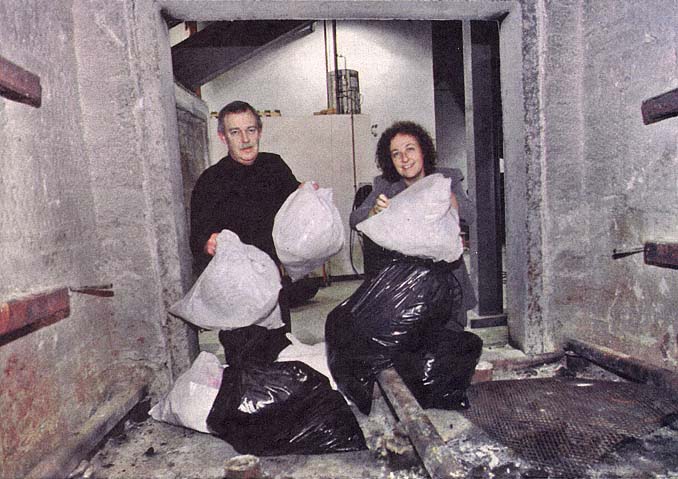|
 |
Process promises cleaner disposal for troublesome waste landfill sites. At the same time, the United Kingdom is looking to reduce its reliance on coal-fired electricity.A GTA firm has received a U.S. patent for a promising solution to a stubborn problemBY DANA FLAVELLE Two former steel-industry engineers say they've come up with a revolutionary new way to burn garbage cleanly and efficiently. Lucy Casacia and Frank Sherman say their process is so good it can even burn old tires and hazardous hospital wastes without producing toxic emissions. The two founders of Eco Waste Solutions Inc., a small high-tech firm in Burlington, recently announced they've acquired a U.S. patent on their process. "We know it's a breakthrough," Casacia told a recent news conference held at Queen's Park. The company said it chose the home of the provincial government to publicize the scientific discovery because "everyone knows garbage is a problem. "We're here to tell government we have an economical solution that's non-polluting, that can be used anywhere," Casacia said. But the provincial government is just one of the target customers for a technology that was developed with the global market in mind, Casacia explained in an interview later. |
PROBLEM SOLVED? Above, Lucy Casacia and Frank Sherma outside a test incinerator, below, the two former steel-industry engineers view a schematic of the equipment at a nearby computer.
|
|
The company has already sold 13 units around the world, including to a tourist destination in Alaska with limited landfill capacity, a hospital in Hawaii, an oil platform in the Gulf of Mexico and five animal shelters in Ontario, where the units are being used for pet cremation. The wide variety of markets and applications for the process was one of the things that attracted t-he First Ontario Venture Fund, a labour sponsored venture capital fund. "All the potential markets for this technology are huge," said First Ontario vice-president David McDonald. "If they become a dominant player in any one of them, they'll do very well.'' The fund has invested $1.2 million in the company so far, said McDonald, producing an undisclosed equity position. One of the most exciting potential markets, McDonald said, is the United Kingdom. With its huge population and small land mass, the country is rapidly running out of
Eco Waste is working with a U.K. partner on a large-scale energy-from-waste application of the process. Eco Waste was an attractive investment for the $65 million fund for other reasons, too, McDonald added. "We look for companies that have something unique in a deep, vertical market where we don't think there will be a lot of competitors. We thought they had a terrific technology and great management," McDonald said. Eco Waste has also received venture financing from Royal Bank Capital Corp., Casacia said. Casacia said the company's much cleaner process will help clean up waste incineration's bad public image. "What people typically see is systems that are 30 years old," she explained. Meanwhile, environmental standards have become increasingly stringent, she said. Some Ontario hospitals have had to abandon their outdated systems and start shipping their used chemotherapy drugs and IV tubes to: plants in the United States for destruction, she said. Casacia said Eco Waste's systems offer a more economical alternative. Operating costs for biomedical wastes average.18 cents a pound compared with the 30 to 40 cents a pound the hospitals now pay to have their waste carted away. The capital cost to buy a system ranges from $250,000 to $4 million, depending on how much garbage will be processed. One option is to have several hospitals pool resources to buy a single unit between them, or have a commercial operator bear the capital cost and charge user fees, she said. Eco Waste's process relies on a two stage burn conducted in two chambers roughly the size of a garbage dumpster. In the first stage, the waste is burned in a low-temperature, starved air condition and reduced to ash and vapours over an 8- to 10-hour period. Any glass and metals are salvaged for recycling before the toxins and vapours move into the second chamber, where they're obliterated in a flash fire, the company says. A computer monitors and controls each burn to ensure the cleanest outcome. Eco Waste's claims have been verified by Mississauga-based ORTECH Environmental, a private company specializing in air pollution issues. ORTECH found Eco Waste's emissions to be well within the Ontario environment ministry's standards for toxic wastes, including dioxins and furans, acid gases and heavy metals, said senior project manager Steve Thorndyke. Eco Waste was founded in 1994 by Casacia, a metallurgist, and Sherman, an engineer' who previously worked at Dofasco Inc. This is Eco Waste's first commercial product. Eco Waste, which employs eight people, expects to add another four within the next year. Projected sales for the next 12 months are in the $10 million range. The company designs, engineers, tests, sells and sevices each system Only the steel cutting, forming and welding are subcontracted out to local suppliers. Assembly is completed in house prior to shipping. In conducting the market research for the product, Casacia said, she was surprised by how similar the issues surrounding garbage disposal are worldwide. "People want to be able to deal with the problem in their own community. That's why we focused on small systems." |
| Back To Science |  |